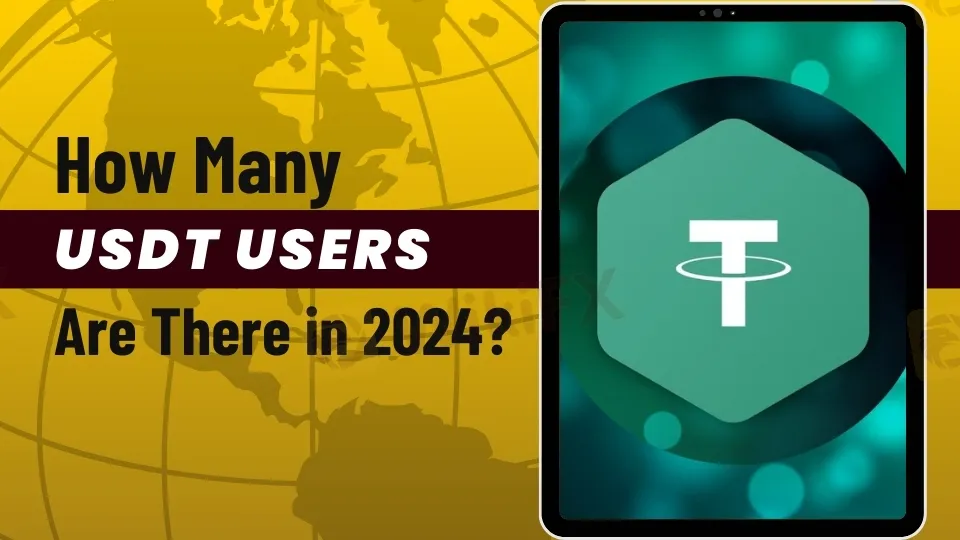简体中文
繁體中文
English
Pусский
日本語
ภาษาไทย
Tiếng Việt
Bahasa Indonesia
Español
हिन्दी
Filippiiniläinen
Français
Deutsch
Português
Türkçe
한국어
العربية
How Many USDT Users Are There in 2024?
Abstract:USDT adoption in 2024 has surged, with over 330 million on-chain wallets and millions more off-chain users, reflecting Tether's growing influence in global finance.

The cryptocurrency landscape is continually advancing, with Tether (USDT) emerging as a significant entity undergoing considerable expansion. The adoption of USDT has achieved significant milestones due to the increasing use of Tether by investors and traders across several blockchains. In 2024, the number of USDT users has surged, demonstrating its increasing significance in the global financial system.
Growth of USDT Wallets and User Demographics in 2024
By the conclusion of Q3 2024, more than 330 million on-chain wallets had been documented, signifying a considerable segment of USDT users. This figure excludes the tens of millions who use USDT off-chain, particularly on centralized platforms, suggesting a much more extensive user base. USDT blockchain data indicate an increasing use of cryptocurrencies by users, facilitating more integration between decentralized and conventional financial institutions.

USDT on-chain wallets are distributed across many sites, with some individuals managing numerous accounts. Blockchain data is a transparent metric; however, the real count of unique users may be somewhat lower owing to people operating numerous wallets.
Principal Factors Influencing the Adoption and Expansion of USDT
The use of USDT has significantly increased across many prominent blockchains, particularly on Ethereum, Tron, and Binance Smart Chain. Ethereum's Layer 2 solutions, such as Optimism, Arbitrum, and Polygon, have emerged as essential drivers of this expansion, supported by reduced transaction costs and expedited processing times.

Furthermore, the introduction of USDT on emerging blockchains such as TON and Celo has seen rapid expansion. TON has independently contributed 3.3 million users, or 1% of all USDT on-chain users over a six-month period, marking it as one of the most notable recent advancements in the Tether ecosystem.
What is the Total Number of USDT Users?
Statistics on USDT user adoption indicate that the user base consistently expands each quarter. Q3 2024 saw a 9% average rise over the prior four quarters, marking one of the most successful periods with approximately 36.25 million additional on-chain users acquired. Off-chain activities exacerbate these statistics since users of controlled services are not reflected in conventional blockchain data.

This increase clearly reflects the growing confidence and dependence on Tether as a stablecoin, especially in countries with the largest cryptocurrency usage, like the US, Asia, Europe, and Latin America.
Conclusion
The increase of USDT users in 2024 is quite exceptional. The integration of on-chain and off-chain wallets signifies that USDT has evolved into a global financial instrument with extensive reach. As the cryptocurrency landscape grows, Tether's function in decentralized finance will persist in evolving, providing solutions that address various markets and customers globally.
Stay updated on the latest USDT developments as adoption continues to surge in 2024.

Disclaimer:
The views in this article only represent the author's personal views, and do not constitute investment advice on this platform. This platform does not guarantee the accuracy, completeness and timeliness of the information in the article, and will not be liable for any loss caused by the use of or reliance on the information in the article.
Read more

Malaysia’s Crypto Landscape: Adapting Amidst Global Ambitions
The United States is intensifying its efforts to become a global cryptocurrency hub under President-elect Donald Trump. Experts believe this move could prompt countries, including Malaysia, to reassess their regulatory approaches toward digital assets.

SEC Approves Hashdex and Franklin Crypto ETFs on Nasdaq
The SEC has approved crypto index ETFs by Hashdex and Franklin Templeton, including Bitcoin and Ethereum, marking a milestone in crypto asset investment.

North Korean Hackers Steal $1.3bn in Cryptocurrency in 2024
Over $2.2bn in cryptocurrency stolen in 2024, with North Korean hackers accounting for $1.3bn. Discover how cyber theft impacts the evolving crypto landscape.

ASIC Sues Binance Australia Derivatives for Misclassifying Retail Clients
ASIC accuses Binance Australia of misclassifying 500+ retail clients as wholesale, denying key consumer protections for crypto derivatives. Penalties and reforms are underway.
WikiFX Broker
Latest News
Top 10 Trading Indicators Every Forex Trader Should Know
ASIC Sues Binance Australia Derivatives for Misclassifying Retail Clients
WikiFX Review: Is FxPro Reliable?
Malaysian-Thai Fraud Syndicate Dismantled, Millions in Losses Reported
Trading frauds topped the list of scams in India- Report Reveals
YAMARKETS' Jingle Bells Christmas Offer!
AIMS Broker Review
The Hidden Checklist: Five Unconventional Steps to Vet Your Broker
WikiFX Review: Something You Need to Know About Markets4you
Revolut Leads UK Neobanks in the Digital Banking Revolution
Currency Calculator


